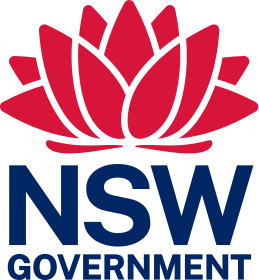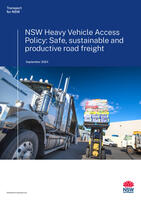
Heavy Vehicle Access Policy
The NSW Heavy Vehicle Access Policy is a roadmap to deliver a fit-for-purpose road freight network.
This roadmap delivers:
- access for the safest, most sustainable and productive heavy vehicles is optimised
- data and technology support greater efficiencies in the freight and supply chain system
The Heavy Vehicle Access Policy (Policy) outlines a new and updated strategic approach to heavy vehicle access in NSW for state, regional and local roads.
The Policy will support an efficient road freight network that is connected to our local communities and commercial hubs, and is integrated with railways, intermodal terminals, ports and airports.
Download the NSW Heavy Vehicle Access Policy
Updated Heavy Vehicle Access Policy
Since the Policy’s original release in 2018, significant improvements in heavy vehicle access have been achieved. This includes key freight routes being unlocked and greater access for higher productivity vehicles.
The Heavy Vehicle Access Policy was refreshed in 2024 to ensure Transport remains responsive to:
- the needs of NSW’s growing population
- impacts of climate change and net zero emission targets
- shifting global trends including the rise of ecommerce
- increase in innovation, technology and data available for heavy vehicles.
The Policy sets out a five-year roadmap and actions to optimise access for the safest, and most sustainable and productive heavy vehicles on NSW state roads.
The Policy was developed based on extensive research and consultation with freight operators and industry, academia, and all parts of government.
The updated Policy is one of the immediate actions recommended by the NSW Freight Policy Reform Panel in its recently released Interim Directions Paper.
Scope
The Policy only applies to access for restricted access vehicles (RAVs), which exceed standard dimensions or masses and therefore require permits or authorisation through notices or schemes to operate on NSW roads.
The focus for the Policy is to enable access for high productivity vehicles, including Performance Based Standards (PBS) vehicles.
RAVs vary but generally include:
- most PBS vehicles Level 2 and above
- B-doubles
- road trains (including modern and traditional A-doubles and A-triples)
- B-triples and AB-triples
- 4.6 metre high vehicles such as livestock vehicles and car carriers
- all heavy vehicles carrying higher mass limits (HMLs), including special purpose vehicles (SPVs) such as mobile cranes, and Oversize Over Mass (OSOM) vehicles.
General access vehicles (GAVs) are allowed unrestricted access to the NSW road network (except where signposted otherwise) and are not in scope.
The Policy also aligns with the NSW Towards Net Zero Emissions Freight Policy to reduce emissions and support the transition to low and zero emission freight vehicles.
Policy principles
The Policy is guided by a set of principles to ensure that it delivers value to our customers and partners and helps achieve Transport’s strategic outcomes and broader community outcomes:
- Optimise customer outcomes – Optimise the safety, sustainability and productivity of heavy vehicles operating on our roads for the benefit of the people of NSW
- Industry certainty – Increase certainty of access to encourage investment in safer and more innovative high productivity vehicles and technologies
- Best first – Make it easiest for the safest, most sustainable and productive vehicles to access the network
- Future focused infrastructure – Ensure network planning and investments are future focused and evidence-based to accommodate new and emerging vehicles, service models and disruptive innovations
- End-to-end connectivity – Collaborate with industry and local councils to improve end-to-end access across the network and enhance efficiencies in the supply chain.
Policy pillars
Agile and resilient networks
Expand access and optimise network capacity and capability
Supporting a growing freight task will require more agile and resilient networks for safely and efficiently moving goods between trade gateways and freight precincts. Key strategic north-south and east-west routes will be prioritised to enable end to end connectivity.
- Proposed access priorities and PBS networks (PDF, 526.13 KB)
- Proposed networks and access conditions for heavy vehicles (PDF, 553.18 KB)
Case Study: Improving access to the Wagga Wagga Special Activation Precinct
The Wagga Wagga Special Activation Precinct (SAP) will establish Wagga Wagga as the key intermodal freight hub for the region, delivering seamless integration between road and rail freight movements and wider economic benefits for the growing population.
Transport is working closely with the Wagga Wagga City Council to facilitate greater access for Performance Based Standards (PBS) vehicles to the SAP. This includes PBS Level 3 for the Olympic and Sturt highways and PBS Level 2B and 3A for key local roads to ensure end-to-end connectivity for these strategic sites.
Current initiatives
Innovative vehicles
Encourage new and innovative vehicles that can deliver improved freight outcomes
The Policy encourages the use of safer and more sustainable high productivity vehicles on the road network by moving to performance-based indicators that seek to maximise the overall safety, operational and environmental performance of the vehicles.
Case Study: Snowy Hydro 2.0 Project, Snowy Mountains Highway
Transport collaborated with industry to design an innovative PBS Level 2 vehicle that was specifically suited for the construction of 27km long tunnels to support the Snowy Hydro 2.0 renewable energy project. The design cut truck trips from 97,000 to about 32,000 trips – a 67 per cent reduction, which delivered significant benefits for the communities of Cooma and Adaminaby in south NSW in terms of congestion, road safety, and noise and air pollution.
Current initiatives
Streamlined access
Reduce administrative and regulatory burden and prioritise access for the best vehicles
We are committed to making access decision-making and processing faster, consistent, more transparent and less complex for applicants.
Case Study: Drought Recovery Freight Initiatives
To support industry to recover from the 2020-21 drought in NSW and take advantage of a forecast large grain harvest, additional access was granted to high productivity vehicles transporting commodities such as fodder, water, grain, and livestock.
Conditional access was granted to road trains on key routes and to priority grain terminals.
Certain high productivity vehicles were granted expanded access into participating local government areas under the Grain Harvest Management Scheme. Increased access saved about 4,275 truck trips and improved productivity by 15 per cent.
Telematics and data
Leverage telematics, data and other technologies to improve network management
We are using data and technology from a wide range of new sources, including telematics, cooperative intelligent transport systems, infrastructure sensors and cameras, to enable a more holistic view of the supply chain.
Case study: Telematics on cranes
Transport has worked closely with the crane industry and Transport Certification Australia to develop a more flexible and cost-effective approach to telematics requirements.
By introducing the Telematics Monitoring Application (TMA) with self-declaration, as an alternative to the current Intelligence Access Program (IAP), road managers can gather relevant data to inform road maintenance and investment planning while ensuring requirements are fit for purpose for industry.
The introduction of TMA with self-declaration ensures that Transport continues to receive information about crane configuration changes and maintains visibility of network use by mobile cranes.
Current initiatives
Strong partnerships
Collaborate with stakeholders to support and improve access
We will continue to collaborate with industry, local councils, other NSW Government agencies and other states and territories to enhance freight outcomes.
Proposed access priorities and PBS networks (Appendix A)
Appendix A focuses on strategic routes strengthening north-south and east-west connections and improving first and last-mile access.
The proposed PBS network outlines Transport’s vision for access which will be progressively implemented as future networks are designed and upgraded.
View Appendix A (PDF, 526.13 KB)
Proposed networks and access conditions for heavy vehicle classes (Appendix B)
This Policy shifts from fixed length restrictions towards evaluating vehicle performance, specifications, and innovative design elements.
View Appendix B (PDF, 553.18 KB)
Innovative vehicle design templates (Appendix C)
Transport has collaborated with industry to design several vehicle templates to provide examples of innovative vehicles that can access the NSW network.
These templates facilitate innovative vehicle combinations that are fit-for-purpose. These vehicle combinations are designed to perform to PBS standards and improve productivity by up to 70 per cent.
Project updates
September 2024: Publication of the NSW Heavy Vehicle Access Policy and summary report (PDF, 169.77 KB) outlining key themes from consultation.
July 2024: Submissions have been published and are available.
June 2024: Consultation on the draft Heavy Vehicle Access Policy closed on Friday 31 May 2024. Feedback will be considered in the development of the final Heavy Vehicle Access Policy.
April 2024: Forming part of the NSW Freight Policy Reform Program, the draft Heavy Vehicle Access Policy was released for consultation.
Visit the Have Your Say on the Heavy Vehicle Access Policy page for information about consultation activities.
Documents
Current documents
- NSW Heavy Vehicle Access Policy (PDF, 10.71 MB)
- Heavy Vehicle Access Policy consultation summary report (PDF, 169.77 KB)
Outcomes from the 2024 consultation with stakeholders on the draft Heavy Vehicle Access Policy
Historical documents
- Draft NSW Heavy Vehicle Access Policy April 2024 (PDF, 4.26 MB)
- The future of heavy vehicles consultation summary report (PDF, 465.84 KB)
Outcomes from the 2022 consultation with stakeholders - The NSW Heavy Vehicle Access Policy Framework
The original Policy released in 2018 - Moving More With Less
Summarises key aspects of the 2018 Policy
Contact us
For further information on the NSW Heavy Vehicle Access Policy email freight@transport.nsw.gov.au.

